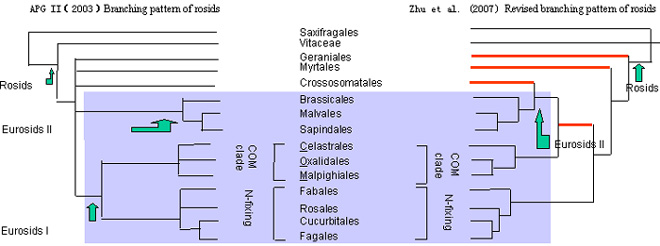The mitochondrial matR single gene and combined four-gene DNA sequences, including matR , rbcL , atpB , and 8S rDNA, were used to examine high-level phylogenetic relationships of rosids. The mitochondrial matR data supported the hypothesis that the deepest split within eurosids might be between the nitrogen-fixing clade and a large clade, including the COM subclade of eurosids I, and eurosids II, which was not resolved by any previous molecular analyses but was recently suggested by floral structural features. Analyses of the four-gene dataset suggested that Geraniales and Myrtales were successively sister to other rosids, Crossosomatales are a sister group to eurosids II, and the core part of rosids should include eurosids I, eurosids II , and Crossosomatales. Evolutionary analyses revealed that slow evolution and relaxed selection make mitochondrial matR suitable for high-level angiosperm phylogenetics ( BMC Evol. Biol. 2007 ) .

Figure A revised branching pattern of rosids (modified from APG II 2003 ) based on mitochondrial matR DNA sequences and combined four-gene DNA sequences from matR , rbcL , atpB , and 18S rDNA. The nodes in red indicate the new supported resolutions from this study 。 (Zhu et al., 2007. BMC Evolutionary Biology )
